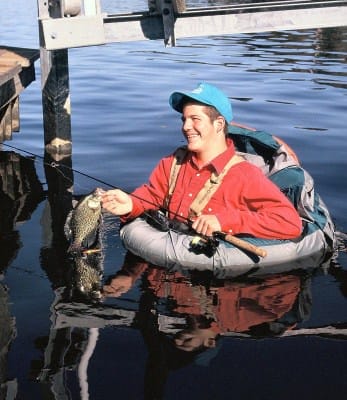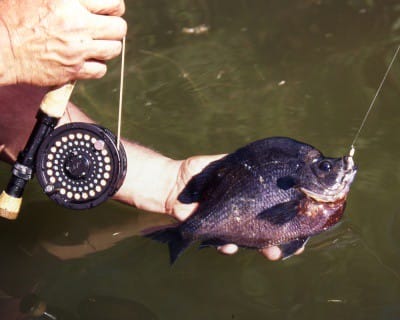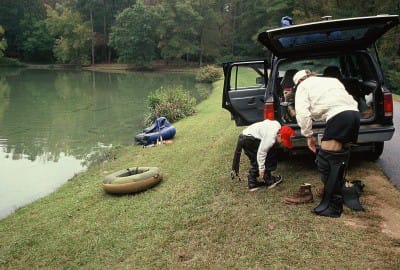
Panfishing from a float tube is easy, inexpensive fishing, not requiring all the equipment trappings of boats and motors, fathometers, and lockers full of fishing tackle. By its nature “donut” fishing for panfish is simple, pleasant, peaceful angling that puts a person as close to the level of the fish as possible. All those are great reasons to fish from float tubes, but best of all, “donuts” often are the most effective means of getting to the best, most untapped panfishing available on any lake, pond, river or stream.
One of the big advantages float tubers have over other anglers is they habitually can get close to fish other anglers have a tough time getting near without spooking. Docks and piers are a prime example. Panfish of all types have an affinity for docks, principally low-to-the-water ones with lots of cross supports and beams. Such docks are the kinds of places offering panfish lots of snags and ambush opportunities for prey, but they can be difficult to fish well from boats or even from docks themselves.

Wading works, but you can cover water better and faster casting from a float tube.
For a float-tuber, working way back under docks – even deep ones – is a piece of cake. An angler should first fish the periphery of a dock with probing casts near pilings and dock overhangs. Then, after thoroughly working the “outside” areas, he should move tighter to the pier and begin careful lure/bait presentations to difficult-to-reach dock water. Sometimes a long cane or telescoping pole is best used for probing under piers. This is called “dab fishing,” and while it takes a bit of practice to perfect, it’s an extremely effective method of pinpoint lure/bait placement around supports underdocks. This is an especially good way of catching finicky bull bluegills, or angler-wise crappies in clear, hard-fished waters.
Bridge supports and lake-river banks with large overhanging trees are similarly fished by savvy panfish anglers in float tubes. Many bridges, especially big ones over broad lakes and rivers, have areas nearly impossible to tap from boats. But from a float tube, they’re easily explored. These are great places to use a boat when float-tubing, which allows long range access and safety. For such deep-water fishing, anglers should be sure to anchor boats well when they leave them for float tubing. And be sure to have some type of ladder or boat stern swim platform for easy tube access.
Not many tube fishermen venture out after sundown, but I know several crappie chasers who rarely use tubes in the day. They’re experts at tapping docks and piers, and target ones having large lights that attract minnows and crappies that feed on them. Best fishing around such docks often is under piers, for anglers who are especially stealthy in their approach – an ideal set-up for float tubes. Night float tubing also is deadly around bridges having lights that reflect down into the water.
One of the beauties of float tubes is their portability. They can be inflated and deflated in minutes, and can be stored in very little space. Some even are easy to backpack into remote panfish havens, such as borrow pits, farm ponds, secluded lakes, and out-of-the-way streams. Such places often can be difficult to fish from the bank, and boats, even canoes, may be tough to transport to the water. Float tubes are the answer, and allow anglers to tap panfish spots that rarely see a bait or lure.
Some crappie and bluegill aces opt for float tubes when fishing standing timber in large reservoir creek arms. Panfish suspended in such timber can be persnickety and difficult to dupe into striking. But when anglers in float tubes stealthily fish live baits or jigs vertically through timber, panfish are more easily fooled. In some waters, floating weeds form nearly impenetrable mats that prevent boaters from reaching quiet backwaters full of panfish. In a float tube, such crappie-bluegill-sunfish spots are a breeze to tap quietly, carefully and effectively.

Today’s commercially-made “float tubes” are much different than the truck tire inner tubes anglers who first started fishing this way employed. Today’s top “tubes” (offered by companies such as Cabela’s, Bass Pro Shops, Caddis, The Creek Company and Orvis) range from simple units to ones with more do-dads and sophistication than a European sports car. But all float tubes share one thing – they allow anglers to quietly, quickly and efficiently fish lakes and rivers, particularly ones with limited or no boat access.
A float-tuber provides propulsion by slowly kicking his feet. Special flippers make tube kicking easy and efficient. It takes a little practice, but in a very short time anyone can learn to move around quietly in a float tube, and soon the kicking motions become second nature and anglers concentrate completely on their fishing – and their catching, too.



